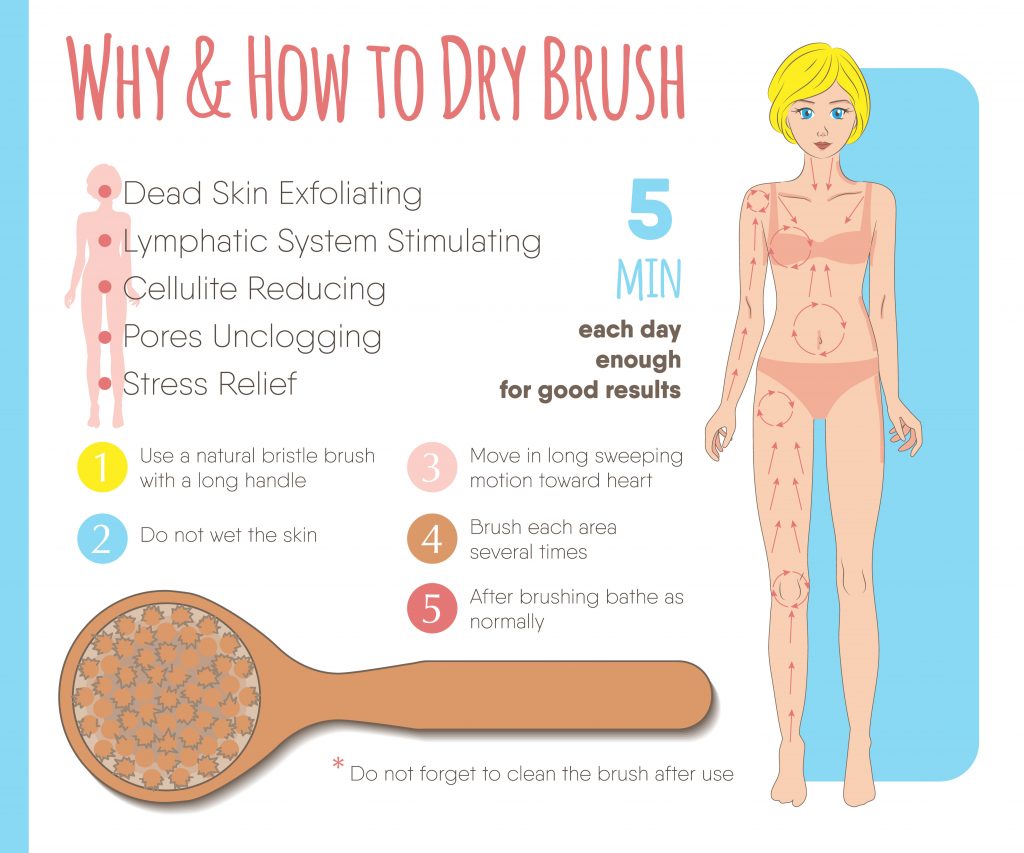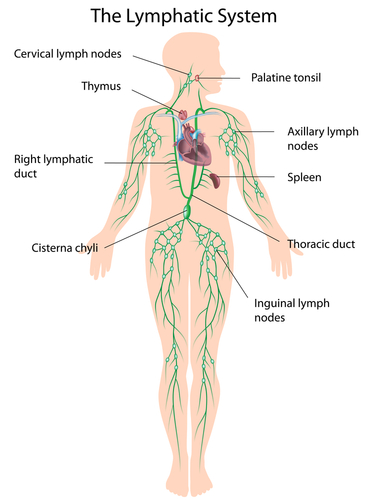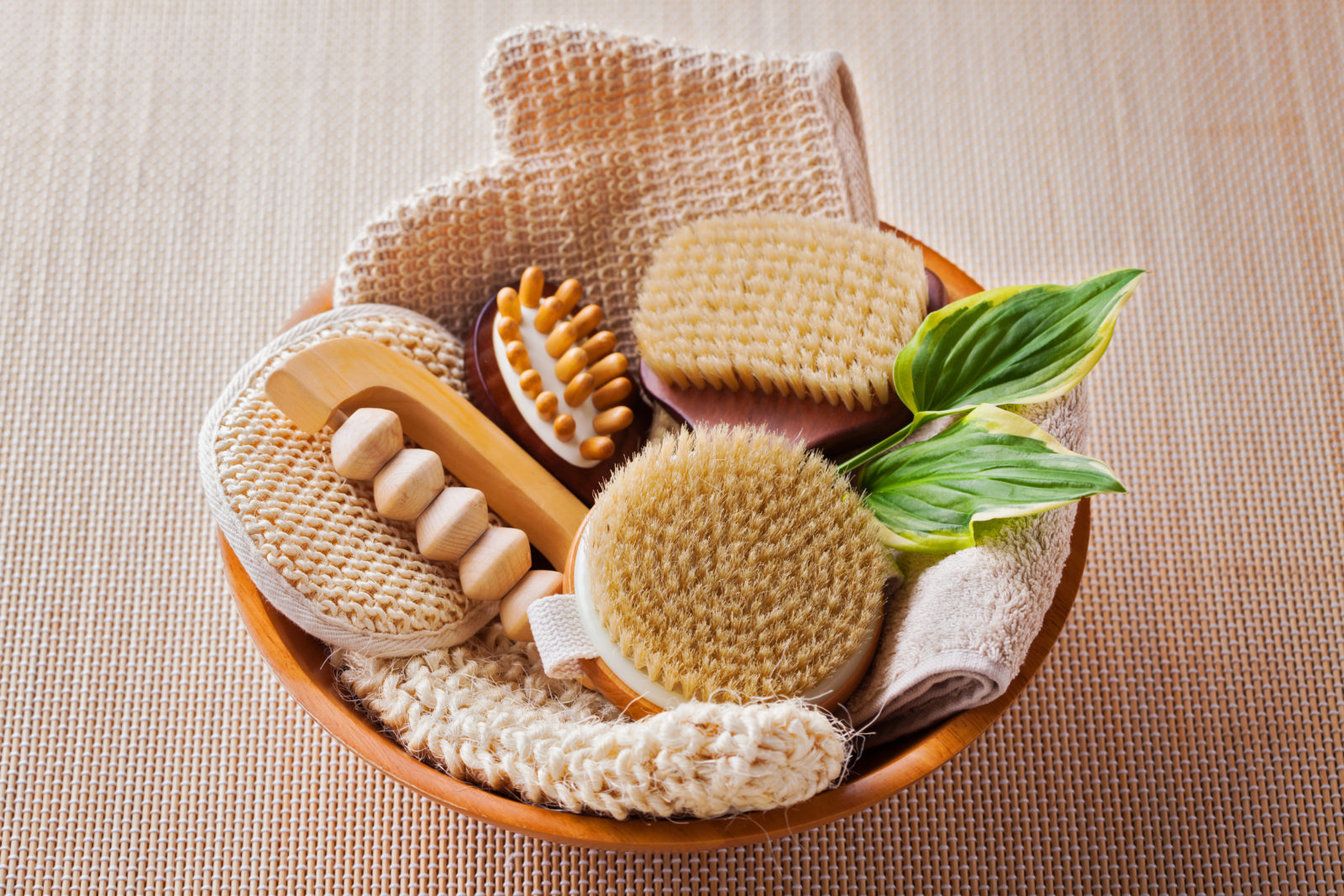Dry brushing is when you use a stiff bristle brush in a specific pattern to help exfoliate the skin and provide numerous other health benefits. This wellness practice has been used since ancient times, but nowadays it is a fairly common pre-shower ritual. Many supporters of dry brushing claim that brushing the skin can help improve the flow of your lymphatic system, however, no clinical study has been done to support this theory. Other touted benefits of dry brushing include getting rid of spider veins, scrubbing away cellulite, helping digestion, or removing toxins however no clinical data currently supports these claims. Most people agree that dry brushing is a great way to help exfoliate your skin.
This is What You Will Need for Dry Brushing
- a dry skin brush or body brush for dry brushing with natural or vegan-friendly bristles
- a dry naked body
- a washroom
- a shower to jump into afterward

Dry Brushing – How to get Started
- Get yourself naked In a room that is not carpeted – dry skin is gonna be cascading off your body, you don’t want it hiding out in the fibers of your carpet.
- Body Brush in hand, start at the base of your feet. To dry brush move upwards in circular or sweeping motions. When dry brushing you always want to move towards your heart. Therefore – from your feet to your breast/chest you are moving up, and from the neck to your breasts/chest, you are moving down.
- Make sure you get your backside, the palms of your hands and your neck.
- Be gentle with the areas of your body where your skin is sensitive. If you are sensitive everywhere, not to worry – use gentle pressure on the body brush and start with only dry brushing for 2-3 minutes.
- Take your time when dry brushing. You are going to want to go over the same area a few times, so work your way up slowly.
- This should be done for between 5-10 minutes
- Take a shower after you are done to wash off your skin.
- Dry yourself off by softly patting down your skin – move towards the heart.
- Moisturize with a natural cream, coconut oil, olive oil or shea butter.
Why You Should Try Dry Brushing Your Skin
Dry brushing is a great way to exfoliate your skin. The stiff bristles on the brush help peel away dead skin cells from the surface of your body, helping unclog any pores.
Dry brushing can potentially help stimulate your lymphatic system. It circulates the body transporting lymph. When you are stagnant or if you injure a lymph vessel lymph can spill into the interstitial matrix creating a lymphatic cyst. Another thing that unhealthy and immobile lymph can create is stretch marks. If you’ve had a major lymph node removed (one located under the armpit, your neck or your groin) dry brushing as well as Manual Lymphatic Drainage (MLD) is essential, primarily in the prevention of swelling of the surrounding body parts located in the vicinity of the removed or damaged lymph node.
The stimulation of the lymphatic system can potentially aid in cleansing the body of toxins as the lymphatic system cleanses some of the body’s waste (in the lymph nodes). The lymphatic system is also responsible for transporting nutrients throughout the body. Therefore increasing the circulation of the lymphatic system aids in increasing the energy flow through the body. Making it a great practice to include in your morning routine. However, no scientific studies support the lymphatic benefits of dry brushing.
Lastly, I shall reiterate the physical beauty it will instill onto you. Apart from making you feel great on the inside, it will also make your outer shell feel amazing. Clearing off dead skin cells by dry brushing will over time leave you with soft skin (if your body is experiencing a rather bad imbalance of nutrients this may implicate this from happening). Softening/eliminating those stretch marks won’t hurt either.
The Lymphatic System
The Lymphatic system is made up of two parts. The first is the lymphatic vessels the second is lymphatic tissues and organs (lymphatic tissue, lymphatic nodes, lymph nodes, the tonsils, the spleen, and thymus).
The lymphatic vessels which run parallel to arteries and veins are responsible for maintaining a balance of fluid within the body. They are very permeable allowing interstitial fluid (a liquid that fills the spaces between a majority of the tissue cells within the body – it resembles blood plasma in composition though it contains less protein) to freely move into them (becoming ‘lymph’ – the fluid that fills and runs through the lymphatic vessels) however, the lymph is prevented from moving out.

As they run parallel to arteries and veins it is very easy for them to drain these areas, as well as other tissues and organs, of waste products (foreign particles, bacteria, cellular debris). The waste stays put in the lymph and is shipped off to lymph nodes. Lymph nodes are responsible for filtering the lymph of all unwanted particles, they are the immunes surveillance and response system. This is aided by white blood cells whose job it is to start antibody production. The waste is filtered out and the remaining lymph is cleansed and sent on route back to the heart.
Like any area in the body, the lymphatic system performs the best when the entire body is functioning in an optimal balance. Low stomach acid, a cut on the arm, an overly alkaline or acidic body, inflammation of any kind all affect – to different degrees – the functioning of the lymphatic system as well, of course, other areas of the body.
They may not impair the function of the lymphatic system – they may simply overwork it. However, it is when an organ or system in the body is overwhelmed that it may stumble and fault. A well functioning lymphatic system will help mitigate against edema, keep up the immune system function and bring nutrients to the cells of the body. Treat your body with kindness and it will treat you kindly in return. Dry brushing is a great way to stimulate and move the lymphatic system.
Other Natural Ways to Improve the Look of Your Skin
- Reduce your stress levels, find some time to relax and de-stress
- Drink enough water and make sure you are not dehydrated
- Supplementing with Vitamin E. Vitamin E helps repair damaged skin
References
(Eds). Angelini, F., Bacci, P.A., Goldman, M.P., Hexsel, D., & Leibaschoff, G. (2006). Cellulite; Pathophysiology and Treatment. New York: Taylor and Francis.
Cummins, D. (2015). Skin Care: Healthy Skin, Dry brushing, Natural Skincare, Acne Help. Audiobook.
Greene, H. (2017). Dry Brushing for Wellness. Audiobook.
Marieb, E. N. (2010). Essentials of human anatomy and physiology with essentials of interactive physiology (10th ed.). Harlow: Pearson Education (US).
Mcclure, K.H. (2015). Dry Brushing: A guide to Improving your skin and health through Dry brushing detoxification. Createspace Independent Pub.
Murray, M. T., Pizzorno, J. E., & M D Michael T Murray (2012). The encyclopedia of natural medicine(3rd ed.). New York: Atria Books.
Price, P. B. (1938). The Bacteriology of normal skin; A new quantitative test applied to a study of the bacterial flora and the disinfectant action of mechanical cleansing. Journal of Infectious Diseases, 63(3), 301–318.
Rawlings, A. V. (2003). Trends in stratum corneum research and the management of dry skin conditions. International Journal of Cosmetic Science, 25(1-2), 63–95.
Regnard, C., Allport, S., & Stephenson, L. (1997). ABC of palliative care: mouth care, skin care, and lymphoedema. BMJ, 315(7114), 1002–1005.
Seeley, R., VanPutte, C. L., Regan, J., & Russo, A. F. (2010). Seeley’s anatomy & physiology – 9th edition (9th ed.). New York: McGraw Hill Higher Education
Amanda Filipowicz is a certified nutritional practitioner (CNP) with a bachelor in environmental studies (BES) from York University. She also has certification in clinical detoxification, prenatal and postnatal care as well as nutrition for mental health. She has been working as a nutritionist since 2013 and is a lifelong proponent of eating healthy.

